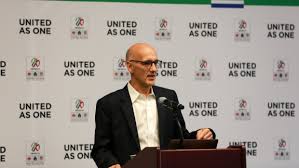By Paul Nicholson
March 16 – The United 2026 World Cup bid have unveiled their 23-city hosting list and while there are a few notable omissions – Vancouver, Chicago, Salt Lake and Minneapolis being the highest profile – it is still an impressive and broad-based power play in the bid battle.
“One thing about our bid is that we have no shortage of cities. We have an oversupply of great cities and venues,” said John Kristick (pictured), the United 2026 bid executive director.
Whittling the list down from 40 applicant cities, then to 32, and now to 23 was done in half the time that was previously available to the US when it bid on its own for 2022 back in 2010. Since then there have been new facilities come on-line in the US – notably Atlanta’s Mercedes-Benz Stadium and Levi’s Stadium in the San Francisco Bay Area – that weren’t there in 2010.
The three-country make-up also shows a diversity to the 2026 World Cup that an expanded 48-team event allows.
FIFA says that between 12 and 16 host venues are required for 2026. The United 2026 bid proposes 16 host cities and, if successful, would have to knock seven off the current list that comprises: Canada: Edmonton, Montreal, Toronto; Mexico: Guadalajara, Mexico City, Monterrey; United States: Atlanta, Baltimore, Boston, Cincinnati, Dallas, Denver, Houston, Kansas City, Los Angeles, Miami, Nashville, New York/New Jersey, Orlando, Philadelphia, San Francisco Bay Area, Seattle, Washington DC.
Kristick emphasises that in terms of facilities the bid offers a lot more than just host cities. “We have 150 world class training sites already existing, we are not talking small facilities,” he said.
“As well as training sites we have base camps, 72 of them, many outside the host cities, that will take the World Cup will touch an even wider base.”
The bid book for the 2026 World Cup comprises 24 chapters from hosting vision and concept to covering strategies for security, volunteers, environmental impact and human rights. Kristick explained that there are a proscribed number of pages, 1,000 in total, with various contracts attached covering government and host cities guarantees that go into tens of thousands of pages. The rival bid from Morocco has to deliver its submission in the same format.
The United bid has as its main three pillars “unity”, “certainty” and “opportunity”. “Three nations with common borders and diverse cultures. FIFA 2:0 is tailormade for joint bids and what we have is a blueprint for this for future joint bidders,” said Kristick.
The certainty in the bid comes from the fact the facilities already exist and are world class. This, said Kristick, would give them the opportunity “to focus on other metrics for the sport and for FIFA worldwide”, rather than focussing on facilities. Building facilities were a huge issue that plagued Brazil, with an expensive financial, social and politically crippling cost attached. They have also caused problems and uncertainty in Russia, though to a lesser degree.
This leads to the overall revenue opportunity of the United bid that similarly cannot be ignored. “We will average 68,000 seats per stadium and expect a 100% sell out. That means $2 billion in ticket revenue,” said Kristick.
“There is also a great opportunity from a sponsorship viewpoint. 25% of the sponsorship market is in the US and 2026 offers the opportunity to re-engage with tremendous pedigree brands.”
With bid books submitted the next stage is an inspection visit from FIFA, expected some time in April. It seems unlikely FIFA will find issue with the venue plan.
FIFA’s voters may find other political and social issues with the bid though.
“We know we have work to do convince the voters,” said Kristick. “We have three governments that are very supportive and working together. Our focus is on basing our bid on its merits and basing it on the interests of football and the World Cup going forward, rather than the politics of the day. 2026 is eight years away.”
If the elephant in the room is Donald Trump and his politics, he will be gone by then.
Contact the writer of this story at moc.l1745118077labto1745118077ofdlr1745118077owedi1745118077sni@n1745118077osloh1745118077cin.l1745118077uap1745118077

